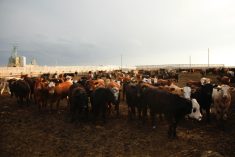Last week, western Canadian yearling markets were traded $2-$4 above week-ago levels from Monday through Wednesday; however, buyers backed away from the market on Thursday and Friday as feeder cattle futures fell nearly $7 from Wednesday’s high. By the end of the week, yearlings were relatively unchanged from week-ago levels.
Calf prices were relatively flat throughout the week although a softer tone was also noted on Friday. Deferred live cattle futures came under pressure late in the week due to concerns about beef demand in the latter half of 2021. At the same time, corn futures and feed grain values remained firm, so the feeding margin structure experienced severe erosion.
Read Also

Alberta crop conditions improve: report
Varied precipitation and warm temperatures were generally beneficial for crop development across Alberta during the week ended July 8, according to the latest provincial crop report released July 11.
Discounts on fleshier yearlings appeared to be more severe, especially in Alberta. Fall-placed calves backgrounded over the winter that were fed too much grain had limited interest. Much of Western Canada has received less than 40 per cent of normal precipitation over the past 60 days. Demand for grassers has waned significantly over the past couple of weeks with limited precipitation in the forecast. Finishing feedlots are stepping forward for these feather-light bawlers but this is mostly to have ownership of well-established yearlings next fall.
In central Alberta, larger-frame medium-flesh tan steers weighing 930 lbs. were valued at $170 and similar quality heifers weighing 940 lbs. were quoted at $166. The steer-heifer spread was quite narrow on higher-quality yearlings. In Manitoba, larger-frame Charolais steers with light butter weighing just over 915 lbs. were quoted at $163 and Simmental heifers averaging 910 lbs. were valued at $161. In the Lethbridge area, larger-frame Angus-blended steers weighing 835 lbs. were quoted at $180 landed in the feedlot and similar-quality heifers weighing 825 lbs. were quoted at $164.
In east-central Saskatchewan, larger-frame lower-flesh Charolais-based steers weighing 700 lbs. were valued at $204 and similar-quality and -weight heifers reportedly dropped the gavel at $186. In southern Saskatchewan, mixed semi-weaned steers averaging 640 lbs. were quoted at $210; north of Calgary, fully weaned Angus-based steers fed light grain on full health program averaging 645 lbs. were quoted at $222.
North of Lethbridge, a small group of weaned Angus-based steers averaging 540 lbs. on full health program coming off light grain diet traded hands at $242; similar-quality heifers weighing 520 lbs. were quoted at $215. The calf market was flat across the Prairies, with Ontario interest holding up Manitoba prices. Buyers were looking for descriptions before taking risk of ownership and vaccinated weaned calves held a slight premium.
This past week, we’ve realized how vulnerable markets can be on negative news. It’s not uncommon for commodity markets to behave similarly on anniversary periods. Keep this in mind when selling feeders, especially yearlings: always note how the market behaved the previous year at the same time.
— Jerry Klassen manages the Canadian office of Swiss-based grain trader GAP SA Grains and Produits Ltd. and is president and founder of Resilient Capital, specializing in proprietary commodity futures trading and market analysis. Jerry consults with feedlots on risk management and writes a weekly cattle market commentary. He can be reached at 204-504-8339 or via his website at ResilCapital.com.














